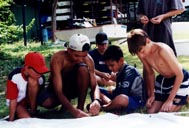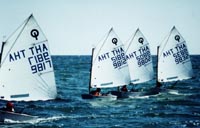





















|
Kingdom of Thailand celebrates Wan Chatramongkhol
His Majesty the King, after studying in Europe returned to Thailand and was crowned King during an elaborate and highly intricate ceremony that out lavished
all previous coronations in Thailand.
A week prior to His being crowned King, on April 28, 1950, H.M. King Bhumibol and Mom Rajawongse Sirikit Kitayakara were married. Following the Coronation
the King returned to Switzerland to continue studying.
The Coronation Ceremony reinforces the stature of the Kings of Thailand. The first such elaborate ceremony was performed when Pho Khun Phamuang succeeded Pho
Khun Bangklangthao as the ruling King of Muang Sukhothai. Phaya Lithai, a former leader in Sukhothai, left a historical record in stone describing the coronation ceremony in
Sukhothai at Wat Srikhum.
In the beginning of the Ratanakosin era, the first King in the Chakri dynasty (King Buddha Yot Fa Chulalokmaharach) took the title of Rama I and moved the
capitol of Siam from Thonburi to the opposite bank of the Chao Phraya River, and constructed Krung Ratanakosin (Bangkok). In the process of building the Royal Palace and Wat
Prakaew (Temple of the Emerald Buddha) the first King in the House of Chakri refined the coronation ceremony, establishing important protocol that has lasted to this day. All
Kings to follow not undergoing the coronation ceremony would be unable to assume the term “Phrabat” in front of the King’s title of “Somdej Phrachaoyuhua”, and more
significantly, the symbol of the nine-tiered umbrella would also not be permissible or officially recognized.
The elaborate coronation ceremony of His Majesty King Bhumibol Adulyadej the Great included all the ancient rituals required for assuming the full title and
the nine-tiered umbrella. King Bhumibol Adulyadej then bestowed the honor posthumously on His brother King Ananda Mahidol. King Bhumibol Adulyadej’s benevolent act raised
King Ananda Mahidol’s regal status from seven to a nine-tiered umbrella.
During the reign of King Mongkut (Rama IV), Buddhist monks and Brahman priests were incorporated into the coronation ceremony to conduct rituals to sanctify
the auspicious occasion. Previously the ceremony was arranged and conducted by the Royal Palace staff and members of the Royal Household.
The annual coronation ceremony is currently a three-day affair, starting with a ritual “tham bun” ceremony on May 3 to honor the King’s ancestors.
Later on the first day, another ceremony is performed, whereby flags of honor are issued to distinguish various military units.
The following day, Buddhist ceremonies continue with chanting rituals, prayers and Brahman priests announcing the auspicious occasion forthcoming the next
day (May 5).
On the 5th of May, His Majesty King Bhumibol Adulyadej the Great (Rama IX) conducts a merit making ceremony, presenting offerings to
Buddhist monks, and leads a “Wienthien” ceremony, walking three times around sacred grounds at the Temple of the Emerald Buddha.
In the evening the King conducts another sacred ceremony: changing the yellow cloth on the Emerald Buddha, the guardian symbol protecting the Thai people,
which was transferred from Thonburi to Wat Phra Kaew by Rama I.
Many rooms in the Royal Palace are opened for public viewing on Coronation Day. Auspicious ceremonies are performed and displays depicting Royal achievements
are exhibited to reconfirm the King’s stature.
Admirals Cup at Pattaya: A perfect show for Optimist sailors
by Peter Cummins
Four Optimist sailors from the Yacht Racing Association of Thailand (YRAT) base in Sattahip, led by new champion 14-year-old Nara Yussawat (13 points),
dominated the just-finished 2001 Admiral’s Cup, sailed off the Royal Varuna Yacht Club, South Pattaya. Second to fourth were Paradon Cheusa-nga (13), Anupong Chaisitnavin
(18) and Pontep Sookudom (19), respectively. Fifth was Sai Chimsawat (20) from the Vichitra Thani Sailing Club at Bangna and, sixth, redeeming the host club’s fortunes, was
15-year-old Norman Lentsch (24). Leader of the fourth club to participate in the event was promising junior, Ariya Hongtiang, representing the Phatra Yacht Club at Pranburi,
who finished eleventh overall.
 Winners at the Admiral’s Cup:
who will go to China? Photo Peter Cummins Winners at the Admiral’s Cup:
who will go to China? Photo Peter Cummins
Elsewhere, Will Hamilton (Royal Varuna, 167), in 31st placing overall, led the rest of the host club team: Joe Connelly (170), Chris Kelly (177, up from
New Zealand for the Cup), Nick Timmerman (179), Antoine De Cuyper (190) and Ludi Lacrosse (190).
Rising Stars
Star performers in the other categories of the competition were: Girls, first was 12-year-old Saiy Chimsawat from Vichitra Thani who finished with a very
good ninth overall, following ‘big brother’ Sai’s fifth placing; Girls, second was 13-year-old Vipavee Trivittayasit (YRAT), who was 13 th overall.
 Al Chandler presents one of the
“Girl prizes”. Photo Peter Cummins Al Chandler presents one of the
“Girl prizes”. Photo Peter Cummins
Then there was the “Under 12” division which saw 11-year-old YRAT sailor Phurit Pholpitaksiri perform extremely well, indeed, to win this category and
finish 10th overall, against the older, bigger children, with his YRAT fellow-sailor Sarin Siriwat, second “Under 12” and 15th overall.
 Royal Varuna Flag Commodore Don
McKenzie makes an award. At left is Admiral Sunan, President of JSST. Photo Peter Cummins Royal Varuna Flag Commodore Don
McKenzie makes an award. At left is Admiral Sunan, President of JSST. Photo Peter Cummins
First beginner boy was 15-year-old Nopanan Boonchan (YRAT), 24th overall and first beginner girl was Pradhana Chanyim, 13, also from YRAT who finished 17 th overall.
Finally, tiny Poonyaporn Chanyim, although she did not win a category, was the sailor with the most initials after her name, finishing 32 nd overall. The nine-year-old little beauty was not only the youngest sailor in the Admiral’s Cup, but also her name in the results sheet was
followed by U.B.F. which sounded to me like the acronym for a bank or something exotic: no; it meant (U) Under 12, (B) Beginner and (F) Female.
 Veerasit: Olympic sailor,
national Laser champ, five times - AND instructor ‘par excellence’. Photo Peter Cummins Veerasit: Olympic sailor,
national Laser champ, five times - AND instructor ‘par excellence’. Photo Peter Cummins
So, at the end of the final day’s racing, there was virtually no change to the pattern set in the earlier races. The first six sailors in the 37-strong
fleet remained that way, with just erstwhile third and fourth places being exchanged, while the rest of the first eighteen were unchanged - rather unusual for a dinghy
regatta. It gave, rather, a good indication of the consistent weather patterns which prevailed throughout the regatta, the predictable performances of the individual sailors
and extremely good race management. “Excellent organization,” said visiting former Royal Varuna Commodore, Lawnin Crawford who has managed Optimist regattas at many
locations, including Burma. “It augurs well for the forthcoming Worlds in China,” he informed the Pattaya Mail Channel during an interview by the PMC’s finest!
Sailing Camp
Since the last big junior sailing event in Thailand, the Eleventh ASEAN Optimist Championship - sponsored by the ‘voice’ of the Eastern Seaboard, the Pattaya
Mail- held at Pattaya a year and a half ago, Royal Varuna has conducted a number of sailing camps, the most recent of which just finished last week.
 Beating out to the start of the
final, deciding race. Photo Peter Cummins Beating out to the start of the
final, deciding race. Photo Peter Cummins
Royal Varuna Junior Sailing Officer, Linden Phanpho, her trusty Brunhilde Schultes and numerous other volunteers - students at the Bangkok and Eastern
Seaboard International Schools and all Optimist graduates themselves - were particularly pleased with the attendance at these latest Optimist training workshops.
 Sam shows the young sailors how
to secure their sail battens. Photo Linden Phanpho Sam shows the young sailors how
to secure their sail battens. Photo Linden Phanpho
These tireless teachers have been busy preparing their young charges with considerable emphasis on racing, honing them up to a competitive edge. Two
siblings, the Kelly boys Chris and Dan came up from their New Zealand abode, Samantha came up as an instructor and Sylvanie came in from Belgium to take part.
Five-time Laser national champion and Sydney Olympic sailor, Veerasit Puangnak also lent his considerable expertise to impart the finer points of sailing
and racing to the more than 20 eager under-16-year-olds who attended the week-long camp at Royal Varuna.
 Tight, close racing was the
feature of the event. Photo peter Cummins Tight, close racing was the
feature of the event. Photo peter Cummins
The most recent week-long event just finished in time for the opening race of the Admiral’s Cup, giving some of the new graduates some real
‘hands-on’ experience in a tough racing situation. “We must have been doing something right at the camp,” said Linden last week, with her usual under-statement.
“Will Hamilton finished in the top half of the fleet of the Kingdom’s best junior sailors, in his first-ever Admiral’s Cup competition - and he was sick, as well,”
Linden added with obvious pride!
 “Learning the ropes”, so to
speak, at the Opti sailing camp. Photo Linden Phanpho “Learning the ropes”, so to
speak, at the Opti sailing camp. Photo Linden Phanpho
The new International Rules of Yacht Racing, covering the triennium 2001 - 2004, were implemented for the first time in an Optimist regatta in Asia and the
race organizers watched with great interest. Mark Pryke, the Australian - albeit ubiquitous - International Juror, was ‘back in town’ to explain the rules.
A Perfect Regatta
The conditions were as perfect as only Mother Nature can make them: moderate, steady southerlies reaching about 15-knots by mid-afternoon, warm water and a
most pleasant - if a little hot - ambient temperature.
 Former Varuna Commodore Lawnin
Crawford: “The Admiral’s Cup was outstanding - great management”. Former Varuna Commodore Lawnin
Crawford: “The Admiral’s Cup was outstanding - great management”.
Placings in this event will be computed with results in the Optimist National Championship to be sailed at Sattahip from the 5th to the 7 th of May, after which Vice Admiral Sunan Monthardpalin, president of the Junior Sailing Squadron of Thailand (JSST) will announce the
composition of Thailand’s first-ever Optimist team to race in the world championship in China. In July, the team of five skippers, the manager and coach will leave for
Quingda, for the Worlds to be raced from 12 - 23 July.
 The new graduates and their
instructors. Photo Linden Phanpho The new graduates and their
instructors. Photo Linden Phanpho
Al Chandler, the motivating force behind Optimist and youth sailing in Thailand - and world-wide as an International and Olympic Judge in the bigger boat
arena - is seeking funding to send these marvelous young people to represent Thailand - and, by extension, all of us – in China. “Each skipper requires Baht 100,000 for
the total package and we are looking for sponsors,” Al pointed out. Already, several long-time junior sailing supporters, such as Harold K. Vickery Jnr., Ralph Tye, Sompob
Intraprasong and Lawnin Crawford have contributed.
 Instructors (L to R): Emilie,
Virginie, and the “two Sams” Samantha and Sam. Photo Linden Phanpho Instructors (L to R): Emilie,
Virginie, and the “two Sams” Samantha and Sam. Photo Linden Phanpho
Any person - whether a sailing enthusiast or not - who saw this great spectacle and the smiling, happy faces of these children at Pattaya last weekend will
no doubt be coming forward to help send an “Opti” to China.
On the other hand, any person who did not have the good fortune to share the joy and camaraderie of these junior citizens and prospective goodwill
ambassadors for the Kingdom in China, can be assured by this writer that helping the Thai team will be also ‘a leg up’ for the Kingdom as well!
Contributions can be sent to the Junior Sailing Squadron of Thailand, c/- 7th Floor, Bubhajit Building, 20 North Sathorn Road Bangkok 10500. Attn: Al
Chandler. Fax 266-6483; 266-6484; e-mail [email protected]
Antiques, are they genuine?
by Apichart Panyadee
Methods of Manufacture
Wrought iron was worked in a forge by the blacksmith. Joints were made either by fusing the iron bars together under intense heat or by riveting them.
Shapes were created by bending the hammered bars around angles on the anvil. Everything was individually produced and each item, however skilfully made, differed slightly
from the next.
 Small fragment of 16th century
cast iron from a set of gates Small fragment of 16th century
cast iron from a set of gates
Each blacksmith would make his own bars for further shaping into tools and objects he wished to make. Thus, all the iron used was hand made and slightly
uneven. Modern wrought iron is made from pre-shaped bars. However, Asian blacksmiths making fakes tend to follow the old methods and make their own forged iron.
When iron was cast into household objects, some were made in moulds, but widespread use was also made of open sand casting. Firebacks, for example, were
made by stamping the decoration in casting sand, and pouring the melted iron directly into the open boxes. Early firebacks are generally very thick; an inch or more, but
modern founders were more sparing with their ore.
The Metal
 True appearance of wear and oxide
on wrought iron True appearance of wear and oxide
on wrought iron
It is possible to analyse iron and steel and determine the proportions of carbon they contain. This helps with dating. The nature of the impurities iron
holds can also identify the fuel used in its forging and therefore help to date the hearth used in its manufacture. Wrought iron is hard to date by analysis as the methods
which were used remained the same over a long period of time and only the use of modern iron now distinguishes today’s blacksmith’s work from earliest productions.
Makers and other marks
Many 19th century and earlier blacksmiths signed their work, but there is no book which can help identify where or when they worked. Local records would
have to be consulted if a particular blacksmith’s work is to be identified. Owner’s initials, marks or inscriptions are seldom found on ordinary items.
Condition
Iron tends to oxidise rather quickly, so it is not difficult to give a wrought iron object the appearance of age. Wear, on the other hand, is not so easy
to copy. Fakers often simulate indiscriminately. Look for wear at the points where an object would have been put to maximum use. The surface of wrought iron ought to be
genuinely worn by a combination of oxide, cleaning, repainting, and wear. This cycle will be repeated frequently over the object’s working life. Genuine wrought iron
usually has a pitted and mottled appearance, even if it has been cleaned. Look for evidence of use and deterioration. Most reproductions will be rusted, but not truly worn,
impacted and corroded.
Updated every Friday
Copyright 2001 Pattaya Mail Publishing Co.Ltd.
370/7-8 Pattaya Second Road, Pattaya City, Chonburi 20260, Thailand
Tel.66-38 411 240-1, 413 240-1, Fax:66-38 427 596; e-mail: [email protected]
Updated by
Chinnaporn Sungwanlek, assisted by Boonsiri Suansuk.
E-Mail: [email protected]
|

The Rotary Club
of Jomtien-Pattaya

Skal
International

Pattaya
Fun City
By The Sea
|